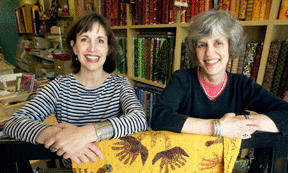A generation or two ago, sewing was an economic necessity, because not everyone could afford “store-bought” clothing.
Today, mass-produced clothes are so inexpensive that sewing has become a means of self-expression – a way to make distinctive or better-fitting clothes, an artistic medium or simply a means of getting together.
The new owners of Island Textiles on Hildebrand Lane hope to promote all of those goals.
“We want to have sewing circles,” said co-owner Deana Guthrie. “People may be changing buttons on a jacket, but they want to do it with girlfriends.”
The store, which opened May 20, will stock a full line of those items that today’s stitchers need – light-weight cottons for quilting, home-decorating fabrics for those doing their own decor, fashion fabrics for clothes-makers – and the materials to make it all happen, like zippers, threads, thimbles and assorted notions.
The store’s modest size prevents them from stocking everything, so they will special-order what is not on display.
Store hours are 9 a.m. to 6 p.m. Monday through Saturday and noon to 4 p.m. Sunday.
While the product line may be similar to the merchandise found at Esther’s on Winslow Way, Guthrie said duplication is being consciously avoided.
“We are not ordering the same things,” she said. “They carry one line of patterns, we are carrying another. We are ordering different quilting fabrics, different threads, so if we don’t have it here you can find it there. The whole point is to keep people from having to leave the island to find what they want.”
Guthrie and partner Maja Stone met while both were working part-time at Esther’s, and Island Textiles grew from that acquaintance.
The two had a lot in common. Both learned to sew as girls and kept at it as adults. And both had been summer-only Bainbridge residents for years before moving here full-time relatively recently.
Stone had worked intermittently in fabric shops since 1963, but for the last 25 years, her husband’s work took them to the Middle East for nine months of every year.
“I became interested in ethnic fabrics during those years,” she said, “and I started to collect them. I always wanted to own a shop, and get people to use their imaginations about what they could do with fabrics.”
Guthrie had learned to sew from her mother and grandmother, and had made clothes for her own children when they were young.
Her interest was piqued by her architect husband’s home-decor library – “I was really drawn to that,” she said – so after moving here last year from Reno, Nev., she went to work at Esther’s, partly to meet more people.
When the two decided to open their own store, they looked for a location outside of downtown Winslow. The spot on Hildebrand, next door to Winslow Paint, was just right, they said.
“We wanted to be at this end of town,” Stone said. “This area has a lot of potential, and there’s an enormous amount of traffic,” she said, adding that much of the auto traffic comes from the south, through the bank parking lot.
While making clothes from scratch may not be a big money-saver, learning to do minor alterations can be so.
“You can definitely save money if you learn to hem your own trousers, sew on a button or replace a zipper,” Guthrie said.
The store plans to offer classes that will enable customers to tackle those tasks.
“A basic understanding of how clothes are made qualifies you to do that work yourself,” Guthrie said.
The other big benefit to the do-it-yourself approach is better fit, Stone said.
“Manufacturers’ stuff is one-size-fits-all, and most of that is loose and baggy,” she said. “We would like to have a class in basic dress-making, how to make a pattern fit properly.”
And they want to promote the art possibilities inherent in fabric, not simply the practical craft. The work of local textile artists will be on display in what they call a “changing gallery environment,” and they will encourage creativity, especially among local students, who will get discounts.
“Quilting is a great medium because it doesn’t have to be done perfectly,” Guthrie said. “But sewing doesn’t have to be limited to quilting, clothing or home decor. If someone wants to make a piece of art out of fabric and thread, they can do it.
“We want to encourage thinking outside the box – the possibilities are endless.”


